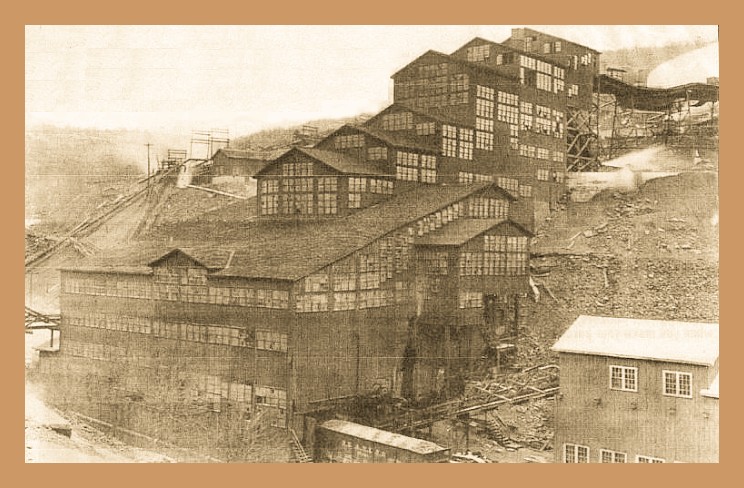The Bast Colliery Breaker, pictured here in a photo taken around 1920, was located near Big Mine Run Creek in Butler Township, Schuylkill County, Pennsylvania.
From a series of articles that appeared in the Pottsville Republican and Herald in 1997:
The Bast Colliery, originally called Big Mine Run East and later the Union Colliery, was located north of Ashland on the east side to Big Mine Creek, Butler Township.
The original opening was one of two drifts driven east and west on the South Dip Mammoth Vein by Gideon Bast, Pearson & Davis in 1853. These two drifts constituted the Big Mine Colliery and were operated as such to 1858, when Emanuel Bast, son of Gideon Bast, purchased the east-lying drift workings from the firm and mined it until 1860, by which time the gangway had been driven 3,000 feet.
The first coal shipment of 5,245 tons was made by Emanuel Bast in 1859.
In 1860, Bast formed a partnership with a Mr. Steinhilbert and the colliery then operated under the name Union Colliery.
In 1863, a slope was sunk 440 feet on the south Dip Mammoth Vein to the first level, from which a gangway was driven eastward. The west gangway was not driven on account of a pillar separating the two collieries.
In 1872, the Philadelphia & Reading Coal & Iron company purchased the colliery, mining the east gangway and extending the slope 350 feet to the second level – a total length of 810 feet from the surface. From the new level, gangways were driven east and west. The west gangway passed under the active Big Mine Run Colliery mined by Taylor & Lindsey.
In 1874, the pump slope, 88 feet east of the hoisting slope, was extended to the third level 800 feet from the surface, and in 1884, the pump slope was sunk to the same level as the coal slope. During the same year the South Dip Mountain Slope was sunk 1,044 feet to the second level and a tunnel was driven south 400 feet to the second level Mammoth gangway.
In 1889, the Mammoth Slope was extended to 300 feet below the second level – a total length of 1,186 feet from the surface – and the pump slope was extended to the same level.
In 1901, the new bottom was changed to hoist gunboats instead of wagons formerly in use. A new lift was also sunk on the Buck Mountain Slope.
In 1890, the breaker was rebuilt and the latest machinery installed.
On January 9, 1912, the Philadelphia & Reading Coal & Iron Company sank a four-compartment coal shaft, each 7 by 12 feet. The same year it sank a rock slope 150 feet east of the new shaft 109 feet to the Skidmore Vein. in 1914, the coal shaft was completed to a depth of 1,159 feet and a tunnel was driven 1,126 feet from the Buck Mountain third level to the coal shaft.
In 1917, the colliery added an electric light system inside and outside the colliery.
The Bast Colliery closed down September 29, 1934. Total shipments as of 1928 were 9,504,288 tons.
_______________________________________________
Article by Frank Blase, Historian, Reading Anthracite Company Historical Library, Pottsville Republican & Herald, June 7, 1997. Obtained from Newspapers.com.
Corrections and additional information should be added as comments to this post.
